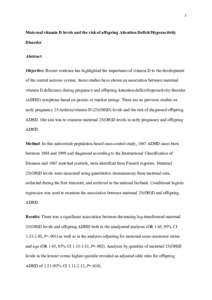Maternal Vitamin D Levels and the Risk of Offspring Attention-Deficit/Hyperactivity Disorder
Andre Sourander; Susanna Hinkka-Yli-Salomäki; Alan S. Brown; David Gyllenberg; ; Minna Sucksdorff; Helja-Marja Surcel; Keely Cheslack-Postava; Roshan Chudal
https://urn.fi/URN:NBN:fi-fe2021042825779
Tiivistelmä
Objective
Recent evidence has highlighted the importance of vitamin D in the development of the central nervous system. Some studies have shown an association between maternal vitamin D deficiency during pregnancy and offspring attention-deficit/hyperactivity disorder (ADHD) symptoms based on parent or teacher ratings. There are no previous studies on early pregnancy 25-hydroxyvitamin D [25(OH)D] levels and the risk of diagnosed offspring ADHD. Our aim was to examine maternal 25(OH)D levels in early pregnancy and offspring ADHD.
Method
In this nationwide population-based case-control study, 1,067 ADHD cases (born between 1998 and 1999 and diagnosed according to the International Classification of Diseases) and 1,067 matched controls were identified from Finnish registers. Maternal 25(OH)D levels were measured using quantitative immunoassay from maternal sera, collected during the first trimester and archived in the national biobank. Conditional logistic regression was used to examine the association between maternal 25(OH)D and offspring ADHD.
Results
There was a significant association between decreasing log-transformed maternal 25(OH)D levels and offspring ADHD both in the unadjusted analyses (odds ratio 1.65; 95% CI 1.33–2.05; p < .001) and in the analyses adjusting for maternal socioeconomic status and age (odds ratio 1.45; 95% CI 1.15–1.81; p = .002). Analyses by quintiles of maternal 25(OH)D levels in the lowest versus highest quintile revealed an adjusted odds ratio for offspring ADHD of 1.53 (95% CI 1.11–2.12; p = .010).
Conclusion
This study demonstrated an association between low maternal 25(OH)D during pregnancy and an elevated risk for offspring ADHD. If replicated in independent samples, this finding may have significant public health implications.
Kokoelmat
- Rinnakkaistallenteet [19207]
